Tea in March Part 2
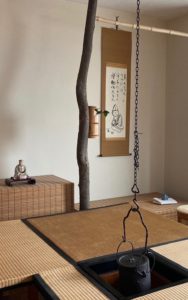
Cha-dō-gu, 茶道具, Tea-way-tools, often used in March have designs reflective of the zodiac animal of the year, 2023 is an U-doshi, 卯年, Hare-year. Seasonal motifs such as cherry flowers, and dragons. The Sei-ryū, 青龍, Azur-dragon, which is one of the four divine creatures that are guardians of the directions, and Seiryū is in the east. The zodiac sign following the Hare is the dragon, Tatsu, 龍.
Dragon motifs on Tea utensils have extensive symbolism. In early Chinese belief, there were five dragons in the heavens, each of a different color, and guardians of the directions. The Seiryū – azure (blue-green dragon) remained in the east. The red dragon in the south, white dragon in the west, black dragon in the north, and yellow dragon in the center. The yellow dragon represented the Chinese emperor.
In Chanoyu, the host, when preparing Tea, sits in the south facing north, and when handling the hi-shaku, 柄杓, handle-ladle, is theoretically moved to the north looking south. Having motifs of dragons (Seiryū in the east) on the kama, and possibly the furo, helps to reinforce the host’s ideological place in the north. And yet, dragons on the kama may be remnants of the white dragon of the west. And what of the kama with its dragons in the ro, near the middle of the Tearoom, being a remnant of the yellow dragon of the emperor in the center?
Another guardian is Ji-koku-ten, 持国天, Hold-country-heaven (deva), who is one of the Shi-ten-nō, 四天王, Four-heaven-kings, who protects the Buddha and Buddhism and reigns in the east. It is believed that he replaced the Seiryū in the heavens. The Shitennō are among the very first Buddhist deities worshipped in Japan.
Other guardians include Mon-ju Bo-satsu, 文殊菩薩, Literary-exceptional Grass-buddha, who is together with Fu-gen Bo-satsu, 普賢菩薩, Wide-wisdom Grass-buddha, guardian of the Buddha, and represents the compassion of the Buddha. He is usually depicted carrying the chi-ken, 智剣, wisdom-sword, and with or riding on a shi-shi, 獅子, lion-of, that is also a symbol of compassion.
In March, Urasenke followers use the tsuri-gama, 釣釜, suspend-kettle. Familiar kama that are used to hang in the Tearoom are somewhat narrow so that should it swing, it wouldn’t damage the delicate surface of the earthen ro-dan, 炉壇, hearth-foundation. Such a kama is the Rikyū choice of the iron un-ryū gama, 雲龍釜, cloud dragon, with its stylized dragon motif and its full kama diameter self-lid with a pattern of concentric water rings. The dragon brings water, rain spewing from its mouth.
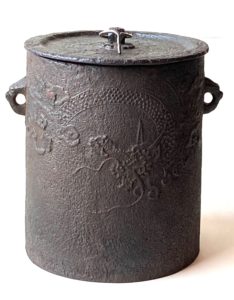
The unryū gama has a form that is unlike the many standard models used in Chanoyu, when it was created in the 16th century by Sen no Rikyū. The pictured kama is used with the ro, 炉, hearth, and there are smaller versions used with the fu-ro, 風炉, wind-hearth. In March, Urasenke uses a tsuri-gama, 釣釜, suspend-kettle, and quite often the unryū-gama is the preferred choice.
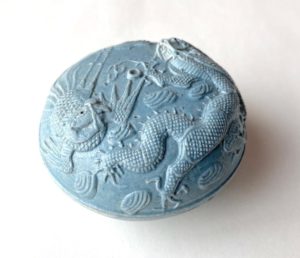
The dragon is symbolic of the emperor, and the phoenix is symbolic of the empress. The dragon, although extremely powerful, is the stuff of myth, non-corporeal, and therefore an aspect of the positive, Yō, principle, whereas, the ‘phoenix’, is based on a real bird that manifests the negative, In, principle. Their juxtaposition is likened to the interlocking commas symbolic of combined In, 陰, and Yō, 陽, symbol of Tai-gyoku, 太極, Great-extremes.
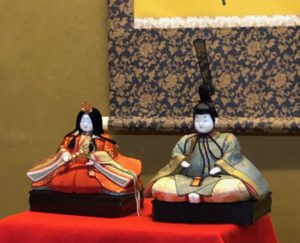
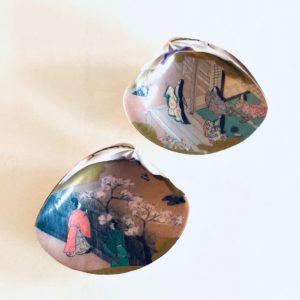
Shells may be depicted as designs and actual clam shells as kō-gō, 香合, incense-gather. A collection of clamshells form a game like ‘War’ called ‘Kai-awase’, 貝合わせ, Shell-gather, in which one tries to re-join separated matching clamshells containing related motifs from the Tale of Genji. A set of 160 matching pairs of shells form part of a bride’s trousseau. One must have a profound knowledge of the Tale.

Gen-ji Kō no Zu, 源氏香の図, Origin-clan Incense ’s Pictures, for Chapter 18, ‘Matsu–kaze’, 松風, Pine Wind. Also present on the front of the pictured natsume below. The first line is at the right, so that it was only one example, while the second and third were the same incense, and the fourth and fifth were the same but different from the second and third.
Another such matching game is Kō-awase, 香合せ, Incense-gather, in which one tries to identify various kings of fragrant woods after having smelled some samples. As part of the game, each participant keeps a tally of the various guesses employing a set of lines that represent the incenses and their similarities and differences.
The most familiar game is closely identified with the Tale of Genji and its chapter names, Gen-ji Kō no Zu, 源氏香の図, Origin-clan Incense ’s Pictures. The game consists of 5 kinds of incense wood divided into five tiny pieces, each of which is put into a small separate envelope. The 25 packets are gathered together, and at random, five packets are selected by the master of the game. Individually, the incenses are put on burners and passed among the guests, who record on their card with five lines, with connecting or not connecting bridges, whether the incense pieces are similar or different as the five burners are circulated. There are 52 possible variations of 5 lines, and there are 54 chapters in the Genji Monogatari, so that the names of the chapters are identified with particular five-line motifs. The first and last chapters are not included in the game.
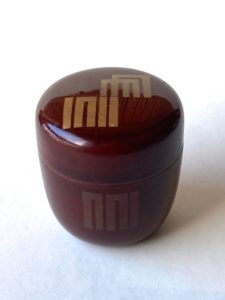
Gen-gen-sai, 玄々斎, Mystery-mystery- abstain, XI Iemoto, Urasenke, greatly admired the Genji Incense game and had created a set of Tea utensils bearing each one or more five-line designs applied to each utensil. For the natsume, 棗, jujube, he had five different motifs as decoration. The motifs on the lid, are Chapter 12, ‘Su-ma’, 須磨, Necessary-polished; Chapter 13, ‘Aka-shi, 明石, Shine-stone: front, Chapter 18, ‘Matsu-kaze’, 松風, Pine-wind: back; Chapter 10, ‘Sakaki’, 榊, Cleyera; Chapter 20, ‘Azuma’, 東屋, East-house.
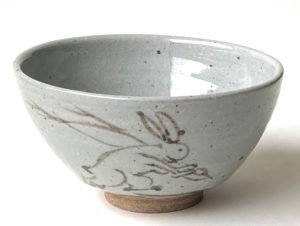
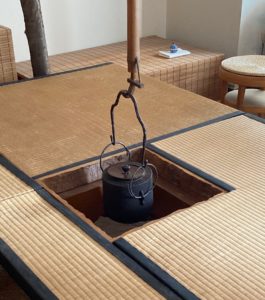
The bamboo pole has nana-fushi, 七節, seven-nodes, like Rikyū’s ro-ji zue, 露地杖, dew-ground-cane, which create six chambers that are symbolic of the Six Realms of Existence in Buddhism: heaven at the top and hell at the bottom. The seven nodes may suggest the Chinese Seven Sages in the Bamboo Grove.
The kama is actually made for a furo, but can be used with the ro because of it narrow profile. Rikyū believed that fine Tea can be made if one had only a single kama.
The biwa wood hook is held by the small wooden piece called a ko-zaru, 小猿, little-monkey, made of bi-wa, 枇杷, spoon-rake, loquat, In Asia, loquats are a favorite food of monkeys, and when the fruit is cut in half in a very special way, the two brown seeds and other parts, it looks a little like the face of monkey. Monkeys are highly symbolic in Buddhism and Shintō, because, in part, of their human-like behavior.
It is written in the Ne-han-kyō, 涅槃経, ‘Nirvana’-Sutra, the Buddha said that all parts of the loquat plant could cure all manner of human disease, and called it the Dai-yaku-ō-jū, 大薬王樹, Great-medicine-king-tree. By using all five human senses, such as smell, touch, eat, and rubbing on the body, all parts of the loquat can be used to restore one’s health. Acupuncture, moxibustion, medicinal herbs, etc. were combined with therapy, and Buddhist medicine was established and introduced to Japan.
For more information on Tea and Japanese culture in March, see also: Tea in March, Unryū Gama, Unryū Gama – A Petal Puzzle, Unryū Gama Picture Gallery, and Rikyū’s Take Jizai.

